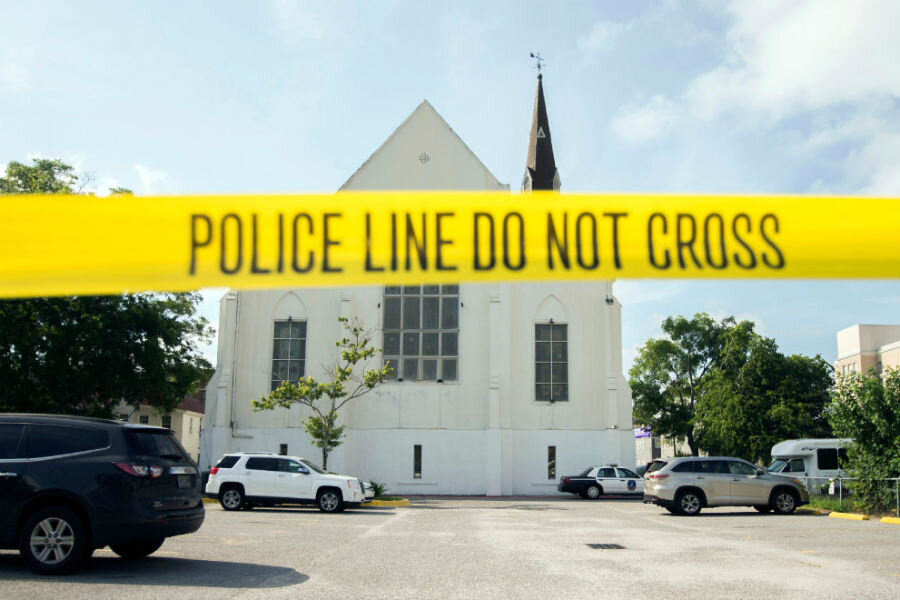What motivated Dylann Roof? Confession offers clues.
Loading...
Dylann Roof's confession was revealed to the public for the first time on Friday, offering a glimpse into the forces that led the now-22-year-old to fatally shoot nine people last year at Emanuel African Methodist Episcopal Church in Charleston, S.C. .
In the two-hour confession, introduced as evidence on the third day of Mr. Roof's federal death penalty trial, the shooter explained to FBI agents his motivations for bringing a .45-caliber pistol into the historic black church on June 15, 2015, and firing 77 shots at churchgoers.
"I had to do it because somebody had to do something," Roof said in the confession, in explanation for the massacre. "Black people are killing white people every day on the street, and they are raping white women. What I did is so minuscule to what they’re doing to white people every day all the time."
Roof's video confession – along with a handwritten journal found in his car, which was also presented as evidence on Friday – provide a deeper look into Roof's descent into white supremacist ideology and his personal motivations for killing three men and six women because of their race, and as FBI reports show an increase in hate crimes nationwide, offer insight into a racist ideology that observers say is spreading.
Roof's trial, which will determine whether he receives the death penalty for his actions, has the power not only to set legal precedent but to make a statement, as Patrik Jonsson reported for The Christian Science Monitor on Friday:
If convicted and sentenced to death, Roof, whose taped confession was shown in court Friday, would be the first person in the United States to face that sanction on a federal level for a hate crime. His trial also marks the first time both the federal government and state prosecutors have pursued death penalty cases against the same person at the same time, according to the Death Penalty Information Center in Washington.
In some ways, the federal death penalty case against Roof represents a White House keen on underscoring that hate has consequences – a message that comes amid a resurgence of reported hate crimes in the US and at a time when minority communities are feeling a fundamental sense of inequality when it comes to justice and race.
The case could, in part, spark a conversation about history that some Americans say is sorely needed.
In his confession, Roof told the FBI that the 2012 killing of Trayvon Martin had been a turning point in his life, prompting him to start researching black-on-white crime on the internet and introducing him to white supremacist ideology.
His story, in this regard, is a common one, says Heidi Beirich, an expert on white supremacist organizations with the Southern Poverty Law Center.
"It’s definitely the case that every time there’s been one of these incidents between white cops and the mostly young black males who have been killed it leads to an increase in membership on white supremacist forums, and engagement – meaning there are threads on those topics, and they end up being the most active threads on the sites," Ms. Beirich told Slate last year. "There’s incredible interest in the white supremacist world in these issues. And they of course see these issues a lot differently than the rest of us, and talk about rampaging black men, good white cops, black people can’t control themselves, that sort of stuff."
Though radical groups such as the Ku Klux Klan may have a significantly smaller presence today than in decades past, Beirich says that, "in general," she "would argue that the white supremacist movement has been growing."
Much of that growth, observers say, is due to the accessibility of white supremacist information on the internet.
"Outspokenness of white supremacists may be on the decline, but white supremacist ideology exists in a range of ages," Dr. R. L’Heureux Lewis-McCoy, an associate professor of sociology at The City College of New York, told The Huffington Post last year. "[T]he Internet has democratized access to white supremacist information. If I am a white high-schooler who feels he has been mistreated while racial minorities have been favored, I’m only a couple of clicks away from a myriad of sites and message boards where I’ll find kinship with folks who are in legion of racial hatred or racial nationalism."
While the internet has provided a forum for white supremacists such as Roof to find others who hold similar views – he told the FBI that he did not discuss matters of race with his family or friends because "they probably won’t agree with me – you know what I’m saying?" – the sentiments espoused by Roof in his confession, journal, and manifesto, including "this supposed need to save white women from black rapists," have historical roots dating back centuries, says Eric Foner, a professor of history at Columbia University in New York.
And though Roof may have been radicalized online in dark corners of the internet, some of his ideas about race may have been formed by his everyday surroundings in South Carolina, Professor Foner writes for The Nation.
"Ideas about history legitimate and shape the present, and public presentations of history tell us a great deal about a society’s values," Foner writes, noting that statues of Klansmen, segregationists, and Confederate generals are more common in the state than monuments to victims of slavery or black leaders of Reconstruction.
"This warped public display of history confronts South Carolinians, white and black, every day with a stark message about who rules the state," he continues. "South Carolina’s leaders cannot abolish the hate that spews forth on the Internet. But if they are serious about changing the way the state remembers and represents its history, let them erect not only a memorial to Reverend Pinckney and the other victims but also statues of the black leaders of Reconstruction and of courageous figures of the civil rights era."








